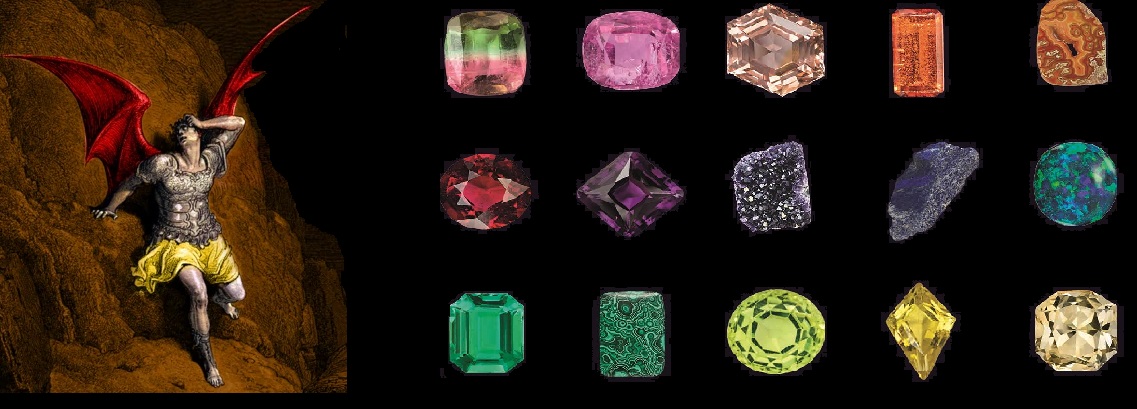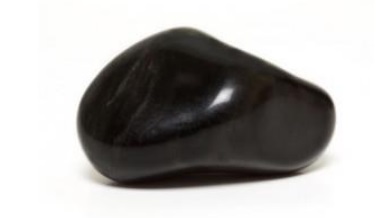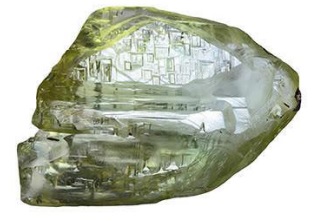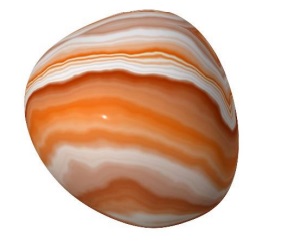One of the most remarkable minds of the medieval Church was St. Hildegard of Bingen (1098-1179), a Benedictine abbess from Germany who wrote extensively on philosophy, theology, music, and medicine. Her best known medical treatise is the Physica, or “The Book of Simple Medicine,” a compendium of knowledge on herbs, trees, animals, gemstones, metals and rivers. Hildegard each case showing the uses of these natural objects for human health. It is also notable for being the first recorded reference to the use of hops in beer as a preservative.
Following a medical tradition that dates back to Greek and Roman writers, Hildegard believed that certain gemstones had healing properties that could be used to treat sickness. The “Book of Gemstones” is Part IV of St. Hildegard’s Physica. This essay will present some excerpts from Hildegard’s “Book of Gemstones,” illuminating beliefs about sickness and the healing properties of stones in the high medieval period. All quotations are taken from Part IV of the Physica, which can be found in English translated by Priscilla Throop.
Medical Theory and the Book of Gemstones
The “Book of Gemstones” gives information on particular gems and how they can be used as medicine and food, sometimes accompanied by a prayer in order to treat specific complaints and ailments. Following the prevailing medical theories inherited from the ancient world, illnesses in Hildegard’s time were usually understood as an imbalance of one of the four elements or ‘humours’ within the human body.
The four principal humours were blood, yellow bile, black bile, and phlegm. Each humour was also associated with one of the four qualities (hot, cold, wet, dry), as well as the four seasons and the four character types; for example, blood was hot and wet, while yellow bile was hot and dry. Health consisted in an equilibrium between these four humours and their respective qualities; sickness was due to an imbalance of these fluids. The job of the doctor was to use the means at his disposal to restore the balance of the humours.

Hildegard’s Teaching on the Gemstones
How could gemstones be used in this endeavor? The prevailing medieval theory, reflected in Hildegard’s writing, was that the stones could be used to treat such imbalances because of specific proportions of the elements of fire and water that occur in the stones when they were formed. Although the use of gemstones for healing may sound esoteric or “New Age” to modern ears, it is important to understand that, for Hildegard and the medievals, this was a naturalistic theory grounded in science, as they understood it.
“All gemstones contain energy and moisture,” Hildegard begins in the preface of her work. This has to do with the natural processes by which they were formed. Hildegard then expounds her theory on the origin of gemstones, believing them to have arisen from a convergence of heat and water from the mountains of the East:
“Precious stones and jewels have their origin in the East, and in those areas where the heat of the sun is particularly strong. The mountains that occur in such areas have a great heat, like fire, which comes from the heat of the sun; similarly, the rivers that flow in these regions are always boiling hot, due to the same great heat of the sun. Accordingly, when at times the rivers flood and break their banks, increasing in volume and rising up to the mountains that are burning with the great heat of the sun, and when these come into contact with the rivers, then, in those places where the water makes contact with the fire, they throw up a kind of foam, in other words they, send out spray, just as a burning piece of iron or stone does when water is poured on it.”
Once the foam has been formed by the heated water, the foam “hangs” and hardens over a period of days. They are now in a proto-gem state, awaiting only the need to be dried in the sun. It is this drying and warming by the sun that will complete their transformation into gemstones—and determine what kind of gemstones they become. Hildegard says:
“…the drops of foam, which remain hanging at various locations in the mountains, are dried by the heat of the sun according to the various hours of the day and their corresponding temperatures. The stones therefore assume their colors and powers according to the temperature of the hour of the day at which they are formed, and once they have dried and hardened into precious stones, they drop like scales from their locations and fall into the sand. And when the rivers rise again in flood, they carry away the gemstones and deposit them in different regions, where eventually they are found by human beings.”
Again, we see that the virtue of the gemstones is entirely naturalistic; Hildegard goes to great lengths to explain that their usage is in accord with principles of natural philosophy and neither magical nor superstitious. As part of the natural order, they are meant for good, and used rightly, are “good and honest and useful to human beings”:
“In this way, then, precious stones are made out of fire and water; they
therefore contain energy and moisture within them and they have many powerful qualities and effects, so that many actions can be carried out with them. These actions are nevertheless good and honest and useful to human beings, and not works of seduction, fornication, adultery, hostility, murder and the like, which are vices in opposition to human beings. For it is the nature of precious stones to seek the honest and useful and reject the evil and false in human beings, in the same way that the virtues throw off the vices, and in the same way that it is impossible for the vices to act in conjunction with the virtues.”
Hildegard does admit that certain gemstones can be used for malignant purposes, and “through these stones both good and evil can be done, according to their natures, and as God allows it.” She then makes an interesting connection between the physical gemstones and the resplendent nature of Lucifer before the fall, which was analogous to the beauty of the stones. This is reminiscent of the description of the devil’s glory before the Fall, as told in Ezekiel 28:12-15 and described in terms of precious stones:
“You were the signet of perfection,
full of wisdom
and perfect in beauty.
You were in Eden, the garden of God;
every precious stone was your covering,
carnelian, topaz, and jasper,
chrysolite, beryl, and onyx,
sapphire, carbuncle, and emerald;
and wrought in gold were your settings
and your engravings.
On the day that you were created
they were prepared.
With an anointed guardian cherub I placed you;
you were on the holy mountain of God;
in the midst of the stones of fire you walked.
You were blameless in your ways
from the day you were created,
till iniquity was found in you.”

This splendor was what filled Lucifer with pride. He exalted himself by virtue of “the beauty of the stones which was in him”:
“God in fact gave the first angel beauty as of precious stones which Lucifer saw shining brightly in the divine mirror, and from these he received his knowledge, and in them he realized that God wished to carry out many marvels. Then his mind was raised in pride, because the beauty of the stones, which was in him, was shining out in God. He thought he could be the equal of God and more, and so his brightness was extinguished. But just as God raised Adam to a better part, so God allowed neither the beauty nor the virtue of the stones to perish, for he wished them to remain in the earth in honour and blessing, and for medicinal use.”
This ties into Hildegard’s belief that the stones have a spiritual value over and above their naturalistic uses. “They terrify the devil,” she says, “who hates and despises them because he remembered that their beauty appeared in him before he fell from the glory which God had given him.” He also hates the gemstones because they are created from heat and energy, and as such, remind him of the punishments that are to come:
“Because some precious stones are created from the fire and energy in which he himself has his punishments. It was in fact by fire that the devil was defeated, through God’s will, and he fell into fire, just as he is also defeated by the fire of the Holy Spirit whenever people are rescued from the devil’s jaws through the inspiring breath of the Holy Spirit.”
So then it must be borne in mind that the power of the gemstones if twofold: in a natural sense, they are capable of healing illness by the heat and moisture within them by virtue of their creation; in a spiritual sense, they terrify the devil and frighten him off. Since it was indeterminate whether many maladies were due to physical problems or demonic influence, the gemstones then possessed a double value inasmuch as they could remedy imbalances both natural and supernatural.
The Virtues of the Stones
Having explored Hildegard’s thought on the origin and uses of the gemstones, let us see what specific virtues she attributes to particular stones.

The emerald—which Hildegard calls the smaragdus—is said to have formed by the first rays of the morning sun, “when the sun is already warm but the air is cold.” It possesses the freshness of grass and morning dew, and as such “smaragdus is therefore effective against all human weaknesses and infirmities, because it is brought forth by the sun and because all its material springs from the greenness of the air.” For pains in the stomach, heart, or liver it should be carried about, and will warm the body. But in case of a sudden malady (for example, an epileptic fit), then the emerald should be placed in the mouth. After the person has revived, they should look at the stone attentively and say: “As the Spirit of the Lord has fulfilled the circle of the earth, so may the house of my body be filled with his grace That it may never again be afflicted.” They should repeat this again and again on the following days in the mornings, and they will be cured, Hildegard assures us. A similar routine is prescribed for headaches: keeping the stone in one’s mouth for an hour while breathing and stroking the temples and forehead.

“Hyacinth,” Hildegard says, “has its origins in fire at the first hour of the day when the air is moderately warm, and thus has more air than fire.” The hyacinth is powerful against maladies of the eyes. “For someone suffering weakness of the eyes, or whose vision is turbid, or whose eyes hurt, hold up the hyacinth to the sun and it will at once recall its generation from fire and warm up quickly. Moisten it immediately in a little saliva and as quickly as possible place it over the eyes so that they are warmed by it. Repeat frequently and the eyes will become clear and healthy. Hyacinth is also recommended for those suffering from demonic oppression. Hildegard recommends baking a loaf of bread, cutting the shape of a cross into the load, then running the hyacinth over the cross while saying, “May God, who deprived the devil of every precious stone after he had broken his commandment, drive out from you, N., all phantasms and all magic spells, and may he release you from all the pain of this madness.” And again, drawing the stone transversely through the bread, they are to say: “Just as the splendor which the devil had was taken from him because of his transgression, so may this madness too, which oppresses you, N. through phantasms and through magic, be taken from you, and may it depart from you!”

“Onyx is warm and grows at the third hour of the day in thick cloud…the stone does not hold great heat of fire, but it has the warmth of the air, for its origin is in the root of the sun and the formation of various clouds. Onyx therefore has great virtues against illnesses arising in the air. Hildegard recommends putting an onyx stone in various drinks to enliven them with its healing properties: for eye problems, drop onyx into your wine basin; for problems of the heart, do the same, only heat the wine first; for a stomach pain, use the onyx-wine as a base from which to make a soup of hen’s eggs and flour; and for fever, “place the onyx in vinegar for fifteen days. Remove the stone, and with this vinegar flavor and season all your food; eat it thus prepared, and the fever will stop and fade easily, because the good warmth of the onyx, mixed with the warmth of the vinegar, will drive out the noxious humours in which the fevers originate.”

Beryl is formed from the foam of the water burned by the sun at midday. As such, it has more of the properties of air and water, less so of fire. Hildegard recommends beryl as a purgative in cases of poisoning. A man who has consumed poison should place a beryl stone in spring water, and fasting for five days, drink the spring water. The beryl will cause him to eject the poison in the form of a foam spewed out the mouth. Hildegard also says beryl can be used as a natural tranquilizer: “Whoever keeps a piece of beryl constantly about them, and frequently takes it in their hand and frequently focusses on it, will not easily argue with other people, nor will they be quarrelsome, but they will remain calm.”

Sardonyx is formed by the sun at high noon, when the power of fire is at its zenith and thus represents the sunlight in its purest form. “It has strong powers in its nature and gives a certain virtue to the five human senses and is a remedy for them, because it is born in the purity of the sun, when no impurity appears in the brightness of the sun. When someone places the stone on their bare skin and also puts it often in their mouth so that their breath touches it, then takes it out and puts it back in again, then this will strengthen their intellect and knowledge, and all the senses of their body. Consequently, great anger, stupidity and indiscipline will be taken from them, and because of their cleanness the devil will hate and flee them.” She also recommends placing a sardonyx gemstone in a ring to be worn by persons recovering from an acute fever as a remedy against relapse.

The sapphire is also formed at midday, but at that time when the heat “passes through the air less readily and [the sun’s] splendor at that period appears not as fully as it does when the air has cooled a little.” Sapphire is therefore opaque in appearance and bears more of a similarity to fire than air or water. Sapphire represents the fullness of wisdom. It has various uses against eye problems, and for someone suffering with gout, Hildegard says, “have them put the stone in their mouth, and the gout will cease.”
Concluding Remarks
While Hildegard’s prescriptions would be rightly considered pseudo-science or quackery today, in her own time they were based on scientific theories as inherited from the Greco-Roman world and agreed upon by all medieval men of science. While her spiritual teachings on the efficacy of the stones to fend off the devil were no doubt influenced by the biblical story of the Fall of Satan, her medical advice drew upon naturalistic assumptions about the world shared by all medieval people (e.g., Humorism, the four qualities, the origin of gemstones, etc.). However saintly Hildegard may have been and however sincere in her estimation of the stones’ virtue, ultimately the naturalistic assumptions upon which her practices were grounded were false. This is no shame to Hildegard—she did the best with the knowledge she had—but it would be foolish for any person today to undertake such remedies. We present Hildegard’s theories here not by way of endorsement, or to suggest they have any medical efficacy, but merely by way of historical interest, so that we might understand the assumptions of medieval science, as well as get a better view into the mind of one of the great personages of the era.

